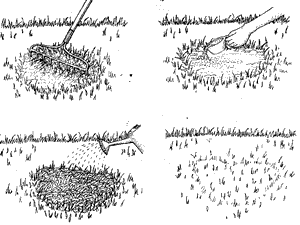Steps for Patching or Repair
Preparing the Soil
Successful lawn patching requires careful soil preparation, even in a relatively small spot. First, remove all remaining plant debris from the area. If the soil has been contaminated by spills of herbicide, insecticide or gasoline, dig out the soil from the area down about 4 inches and discard it in the trash. Replace this soil with good topsoil from another place in the yard or with a bagged commercial topsoil product.

Next, loosen the soil down at least 3 or 4 inches with a trowel, a garden rake or hand cultivator. In clay soil situations add some peat moss or compost, if it is available. This is a good time to mix in a handful of a granular seed starting fertilizer or slow-acting lawn fertilizer. Then rake the area smooth. Finally, water the spot well before putting down any seed or sod.
Options for Patching
Patch with Sod: If the damaged spot is a square foot or more in size, sod is the easiest way to make an instant repair. You can usually buy small pieces of sod in the most popular grass varieties at the garden or home center during the growing season. Try to buy sod made of grass similar in color and texture to your existing turf. Be sure the prepared soil in the spot is an inch or so below the level of the regular turf, so the replacement sod will be at the same level. Cut the sod to fit the space so that its edges are snug against the existing turf. Be prepared to water the spot a couple of times a day for a month or more if the weather is warm until the sod roots penetrate the soil.
Patch with Seed: Sprinkling seed on the prepared soil works perfectly well, but takes longer to fill in the spot. Choose a premium seed mixture or blend that is similar in color and texture to your existing lawn. Sprinkle the seed over the prepared soil fairly thickly, tamp it down with your hands, and then put down a protective mulch of straw or white, polyspun garden fleece. An alternative is to use a lawn patch kit that includes mulch material with the seed. Most seeds take at least 10 days to 2 weeks to germinate, so be patient. Water often enough to keep it constantly moist.
Patch with Plugs: In areas where warm-weather grasses flourish, a common way to patch a problem area in the lawn is to plant small “plugs” or grass seedlings. Certain southern grasses such as St. Augustine grass, Bermuda grass, centipede grass, and zoysia grass are sold as pre-rooted plugs at many nurseries and garden centers. Be sure to prepare the soil well, and water the baby grass plants faithfully until they develop good roots and begin to spread.
